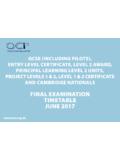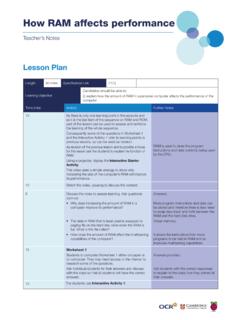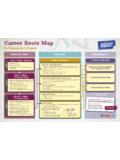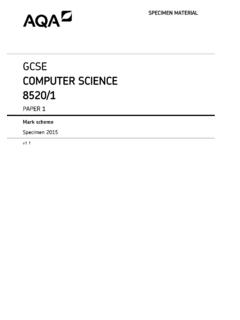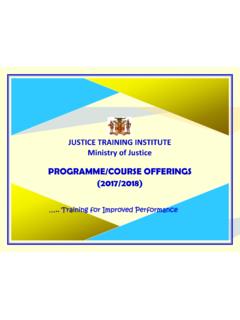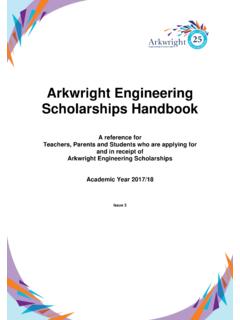Transcription of GCSE COMPUTER SCIENCE 8520/1 - …
1 Specimen paper 1 8520/1 SPECIMEN MATERIAL gcse COMPUTER SCIENCE 8520/1 Paper 1 Specimen 2015 am/pm Time allowed: 1hr 30mins Materials There are no additional materials required for this paper. Instructions Use black ink or black ball point pen. Use pencil only for drawing. Answer all questions. You must answer the questions in the spaces provided. Some questions will require you to shade a lozenge. If you make a mistake cross through the incorrect answer. Do all rough work in this book. Cross through any work that you do not want to be marked. You are free to answer questions that require a coded solution in whatever format you prefer as long as your meaning is clear and unambiguous.
2 You must not use a calculator. Information The marks for questions are shown in brackets. The maximum mark for this paper is 80. You are reminded of the need for good English and clear presentation in your answers. Please write clearly, in block capitals, to allow character COMPUTER recognition. Centre number Candidate number Surname Forename(s) Candidate signature 2 Specimen paper 1 Answer all questions in the space provided. 0 1 Two COMPUTER programs that add together two numbers are shown in Figure 1. One is written in a high-level language and the other is written in a low-level language. Figure 1 High-level program Low-level program x = 12 y = 3 z = x + y 0001 1100 0010 0001 0001 0011 0010 0010 0011 0001 0010 0011 0 1.
3 1 Shade two lozenges to give the reasons why COMPUTER programs are most commonly written in high-level languages instead of low-level languages. [2 marks] A It saves the programmer time. B The programs will always run faster. C Program code written in high-level language is often easier for humans to understand. D Computers understand only high-level languages. E The programs are often easier for a COMPUTER to decode. 0 1 . 2 The low-level program shown in Figure 1 is written in machine code. Suggest two reasons why it would have been better for the programmer to use assembly language instead of machine code.
4 [2 marks] Reason 1 Reason 2 4 3 Specimen paper 1 Turn over 0 2 Figure 2 contains a subroutine that returns a value. Figure 2 SUBROUTINE TotalOut(a, b) c a + b WHILE a < c a a + 1 b b a ENDWHILE RETURN b ENDSUBROUTINE 0 2 . 1 Complete the trace table below when the subroutine call TotalOut(3, 4) is made (you may not need to use all of the rows in the table): [3 marks] a b c 0 2 . 2 A programmer mistakenly tries to shorten the subroutine in Figure 2 by replacing the lines: c a + b WHILE a < c With the line: WHILE a < (a + b) Explain why this change is a mistake.
5 [2 marks] 4 Specimen paper 1 0 2 . 3 What value is returned by the subroutine call TotalOut(x, 0) where x is any positive integer? [1 mark] 6 5 Specimen paper 1 Turn over There are no questions printed on this page Turn over for the next question DO NOT WRITE ON THIS PAGE ANSWER IN THE SPACES PROVIDED 6 Specimen paper 1 0 3 Black and white bitmap images can be encoded using 1 to represent black and 0 to represent white and arranging the pixels in a two-dimensional array. The algorithm in Figure 3 calculates the number of black pixels in a bitmap image stored in a two-dimensional array called image, which has 4 rows and 3 columns.
6 Four parts of the code labelled L1, L2, L3 and L4 are missing. Figure 3 For this algorithm, array indexing starts at 1. num_of_black L1 num_of_rows 4 num_of_cols 3 x 1 WHILE x L2 num_of_rows y 1 WHILE y num_of_cols IF image[x][y] = L3 THEN num_of_black num_of_black + 1 ENDIF y L4 ENDWHILE x x + 1 ENDWHILE 0 3 . 1 Shade one lozenge to show which value should be written at point L1 of the algorithm in Figure 3. [1 mark] A -1 B 0 C 1 0 3 . 2 Shade one lozenge to show which operator should be written at point L2 of the algorithm in Figure 3. [1 mark] A = B C 7 Specimen paper 1 Turn over 0 3.
7 3 Shade one lozenge to show which value should be written at point L3 of the algorithm in Figure 3. [1 mark] A -1 B 0 C 1 0 3 . 4 Shade one lozenge to show what code should be written at point L4 of the algorithm in Figure 3. [1 mark] A x B x + 1 C y D y + 1 4 8 Specimen paper 1 0 4 The algorithm in Figure 4 is the binary search algorithm designed to search for a value within an array. Figure 4 0 4 . 1 Complete the trace table for the algorithm in Figure 4 (you may not need to use all of the rows in the table).
8 The final value of left is already given. [5 marks] val left right mid arr[mid] 4 0 4 . 2 Why would the binary search algorithm shown in Figure 4 not work when the array arr contains [5, 3, 13, 872, 655, 43]? [1 mark] Line numbers are included but are not part of the algorithm. For this algorithm, array indexing starts at 1. 1 val 43 2 arr [3, 5, 13, 43, 655, 872] 3 left 1 4 right LENGTH(arr) 5 WHILE left right 6 mid (left + right) DIV 2 7 IF val arr[mid] THEN 8 right mid 9 ELSE 10 left mid + 1 11 ENDIF 12 ENDWHILE 9 Specimen paper 1 Turn over 0 4.
9 3 There are alternative statements that could have been used on line 5 of the algorithm shown in Figure 4 that would not change the functionality of the algorithm. Shade one lozenge to show which of the following lines could not replace line 5 in Figure 4 as it would change the functionality of the algorithm. [1 mark] New Line 5 A WHILE left < right B WHILE NOT (left = right) C WHILE left < right AND left > right D WHILE left < right OR left > right Question 4 continues on the next page 10 Specimen paper 1 0 4 . 4 The final value of left in the algorithm shown in Figure 4 is 4.
10 A programmer realises that they can use this value to check whether val has been found or not in the algorithm shown in Figure 4. The programmer wants to extend the algorithm and introduce a new variable called found that is true when the value has been found in the array or false otherwise. Write the pseudo-code or draw the flowchart that is needed to extend the algorithm so that when the algorithm finishes, the new variable found is: true when val is found in arr false when val is not found in arr This code should follow on from the end of the algorithm in Figure 4. [4 marks] 11 11 Specimen paper 1 Turn over 0 5.










